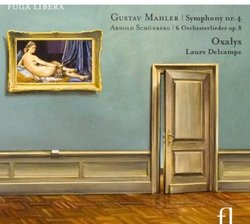As heard at Schönberg's Post-WW1 Musical Society...
Sébastien Melmoth | Hôtel d'Alsace, PARIS | 06/16/2009
(5 out of 5 stars)
".
Well!--for once the Amazon Product Description is spot on: "Mahler's paradisiacal Symphony No. 4 and Schoenberg's sumptuous Lieder Op. 8 were executed simultaneously in a significant concert in January 1921. Oxalys revives this key event by inviting us to a concert in which its bright soloists and Belgian soprano Laure Delcampe teach us a subtle lesson of transparency."
After WW1 Schönberg, Berg, and Webern formed a Society for the Private Performance of Music where modern music could be heard in chamber reductions (small ensembles and piano solo or four-hands).
The catholicism of the Society's programmes is illustrated by a partial list of the composers whose works were performed:
Bruckner, Debussy, Dukas, Korngold, Mahler, Ravel, Reger, Satie, Schmidt, Schreker, Skryabin, Zemlinsky.
In this case, these 1921 transcriptions are for the delicious ensemble of:
flute, oboe, clarinet, string quartet, double-bass, piano, harmonium, and percussion--with soprano, of course.
(The now extinct and virtually forgotten harmonium was a very important instrument in its heyday, c.1875-1925.)
This is a lovely realization of Mahler's most accessible Symphony.
The Opus 8 set of Schönberg's Orchestral Songs is quintessentially representative of his First Period ethos, featuring Wagnerian effects and whole-tone scales.
* * * * *
Further Recommendations:
Mahler Symphony No. 4; Lieder eines fahrenden
Mahler: Symphony No. 4 - Arranged by Erwin Stein
Mahler: Das Lied von der Erde (Arranged by Schoenberg)
.
Bruckner: Symphony 3 (arr. Gustav Mahler for 2 pianos)
Bruckner: Symphony No. 7 (Arranged for Chamber Ensemble)
Bruckner: Symphony No. 7
Bruckner: Symphony No. 7
.
Debussy, Reger, Schönberg & Webern arranged for chamber ensemble
.
Waltz Reflections
.
."


 Track Listings (10) - Disc #1
Track Listings (10) - Disc #1